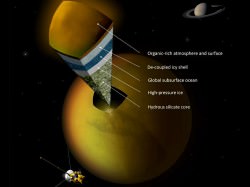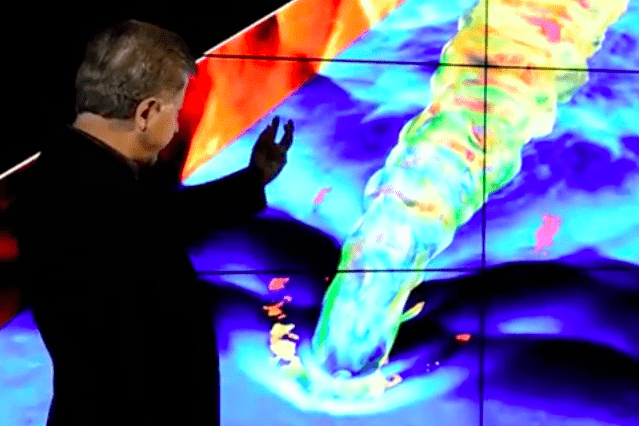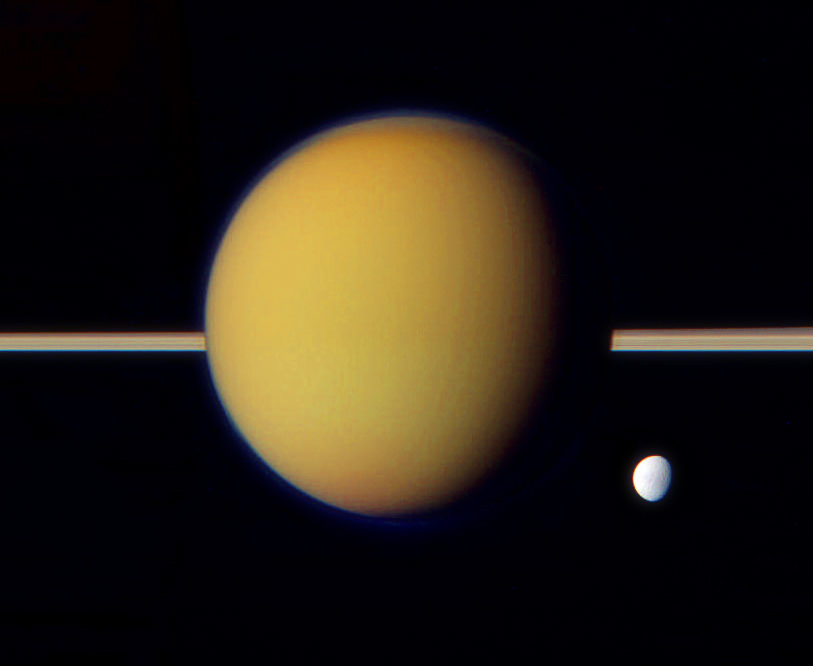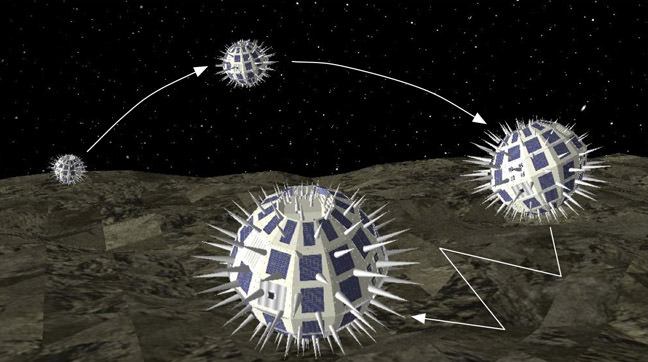Saturn’s largest moon, Titan, is a fascinating and mysterious world, a world literally shrouded in mystery due to thick clouds that cameras imaging in the visible spectrum cannot penetrate. This was made apparent when NASA’s Pioneer 11 became the first spacecraft to fly past Titan in 1979, and then NASA’s Voyager 1 and 2 in 1980 and 1981, respectively. All three spacecraft were equipped with cameras that were unable to penetrate Titan’s atmosphere of thick clouds, although atmospheric data from Voyager 1 suggested Titan might be the first body, aside from Earth, where liquid might exist on its surface.
Continue reading “Titan is an Alien World, but Surprisingly Familiar”Titan’s Gravity Indicates a Thicker, Uneven Icy Crust
Color composite of Titan and Dione made from Cassini images acquired in May 2011. (NASA/JPL/SSI/J. Major)
It’s long been speculated that Saturn’s moon Titan may be harboring a global subsurface ocean below an icy crust, based on measurements of its rotation and orbit by NASA’s Cassini spacecraft. Titan exhibits a density and shape that indicates a pliable liquid internal layer — an underground ocean — possibly composed of water mixed with ammonia, a combination that would help explain the consistent amount of methane found in its thick atmosphere.
Now, further analysis of Cassini gravity measurements by a Stanford University team has shown that Titan’s ice layer is thicker and less uniform than originally estimated, indicating a more complex internal structure — and a stronger external influences for its heat.
Titan’s liquid subsurface ocean was previously estimated to be in the neighborhood of 100 km (62 miles) thick, sandwiched between a rocky core below and an icy shell above. This was based on the behavior of Titan in its orbit — or, more precisely, how Titan’s shape changes along the course of its orbit, as measured by Cassini’s radar instrument.
Because Titan’s 16-day orbit is not perfectly circular the moon experiences a stronger gravitational pull from Saturn at certain points than at others. As a result it’s flattened at the poles and constantly changing shape slightly — an effect called tidal flexing. Along with the decay of radioactive materials in its core, this flexing generates the internal heat that helps keep a subsurface ocean liquid.
 A team of researchers from Stanford University, led by Howard Zebker, professor of geophysics and electrical engineering, used recent Cassini measurements of Titan’s topography and gravity to determine that the icy layer between the moon’s surface and ocean is up to twice as thick as previously thought — and it’s considerably thicker at the equator than at the poles.
A team of researchers from Stanford University, led by Howard Zebker, professor of geophysics and electrical engineering, used recent Cassini measurements of Titan’s topography and gravity to determine that the icy layer between the moon’s surface and ocean is up to twice as thick as previously thought — and it’s considerably thicker at the equator than at the poles.
“The picture of Titan that we get has an icy, rocky core with a radius of a little over 2,000 kilometers, an ocean somewhere in the range of 225 to 300 kilometers thick and an ice layer that is 200 kilometers thick,” said Zebker.
Different thicknesses of Titan’s ice layer would mean that there’s less heat being generated internally by the decay of radioactive materials in Titan’s core, because that type of heat would be more or less globally uniform. Instead, tidal flexing caused by the gravitational interactions with Saturn and neighboring smaller moons must play a stronger role in heating Titan’s insides.
Read more: Titan’s Tides Suggest a Subsurface Sea
With Cassini’s new measurements of Titan’s gravity, Zebker and his team calculated that the icy layer below Titan’s flattened poles is 3,000 meters (about 1.8 miles) thinner than average, while at the equator it’s 3,000 meters thicker than average. Combined with the moon’s surface features, this makes the average global thickness of the ice layer to be more like 200 km, not 100.
Heat generated by tidal flexing — which is more strongly felt at the poles — is thought to be the cause of the thinner ice there. Thinner ice would mean there’s more liquid water beneath the poles, which is denser and thus would exert a stronger gravitational pull… exactly what’s been found in Cassini’s measurements.
The findings were announced Tuesday, Dec. 4 at the AGU convention in San Francisco. Read more on the Stanford University news page.
The Awesome Complexity of Hypersonic Flight

Researchers at Stanford University are working on solutions to the inherent difficulties of hypersonic flight — speeds of over Mach 5, or 3,000 mph (4828 km/h) — and they’ve created one amazing computer model illustrating the dynamics of air temperature variations created at those intense speeds.
[/caption]
According to a news article from Stanford University, “Real-world laboratories can only go so far in reproducing such conditions, and test vehicles are rendered extraordinarily vulnerable. Of the U.S. government’s three most recent tests, two ended in vehicle failure.”
The video above shows some of the research team’s animation model — one of if not the largest engineering calculation ever created, it ran on 163,000 processors simultaneously and took 4 days to complete! And it’s utterly mesmerizing… not to mention invaluable to researchers.
“It’s something you could never have created unless you put computer scientists, mathematicians, mechanical engineers and aerospace engineers together in the same room,” said Juan Alonso, associate professor of aeronautics and astronautics at Stanford. “Do it, though, and you can produce some really magical results.”
In a (very tiny) nutshell, the behavior of air through an hypersonic engine — called a scramjet (for supersonic combustion ramjet) — changes at extremely high speeds. In order for aircraft to travel and maneuver reliably the scramjets have to be engineered to account for the way the air will respond.
“If you put too much fuel in the engine when you try to start it, you get a phenomenon called ‘thermal choking,’ where shock waves propagate back through the engine,” explained Parviz Moin, the Franklin P. and Caroline M. Johnson Professor in the School of Engineering. “Essentially, the engine doesn’t get enough oxygen and it dies. It’s like trying to light a match in a hurricane.”
“Understanding and being able to predict this phenomena has been one of the big challenges. It’s not one number or two numbers that come out of it at the end of the day… it is all of these structures that you see back there, the richness of it. It is understanding that allows you to control.”
– Parvis Moin, Stanford University professor
Thanks to this study, made possible by a 5-year $20 million grant from the U.S. Department of Energy, we may one day have aircraft that can travel up to 15 times the speed of sound. But the team’s groundbreaking computations aren’t just reserved for aeronautic aspirations.
“These same technologies can be used to quantify flow of air around wind farms, for example, or for complex global climate models,” said Alonso.
Read more on the Stanford University News here.
Video by Steve Fyffe and Linda Cicero. Source: Stanford University.
Space Exploration By Robot Swarm
[/caption]
With all there’s yet to learn about our solar system from the many smaller worlds that reside within it — asteroids, protoplanets and small moons — one researcher from Stanford University is suggesting we unleash a swarm of rover/spacecraft hybrids that can explore en masse.
Marco Pavone, an assistant professor of aeronautics and astronautics at Stanford University and research affiliate at JPL, has been developing a concept under NASA’s Innovative Advanced Concepts (NIAC) Program that would see small spherical robots deployed to small worlds, such as Mars’ moons Phobos and Deimos, where they would take advantage of low gravity to explore — literally — in leaps and bounds.
Due to the proposed low costs of such a mission, multiple spacecraft could be scattered across a world, increasing the area that could be covered as well as allowing for varied surfaces to be explored. Also, were one spacecraft to fail the entire mission wouldn’t be compromised.
The concept is similar to what NASA has done in the past with the Mars rovers, except multiplied in the number of spacecraft (and reduced in cost.)
The robots would be deployed from a “mother” spacecraft and spring into action upon landing, tumbling, hopping and vaulting their way across low-mass worlds.
In addition to providing our first views from the surfaces of such worlds, Pavone’s hybrid rovers could also help prepare for future, more in-depth exploration.
“The systematic exploration of small bodies would help unravel the origin of the solar system and its early evolution, as well as assess their astrobiological relevance,” Pavone explains. “In addition, we can evaluate the resource potential of small bodies in view of future human missions beyond Earth.”
Read more from NASA’s Office of the Chief Technologist here.
Photo courtesy of Marco Pavone



